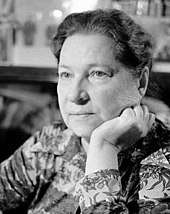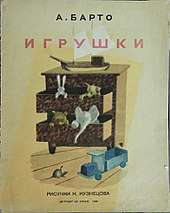Agniya Barto
Agniya Lvovna Barto (Russian: А́гния Льво́вна Барто́, IPA: [ˈaɡnʲɪjə ˈlʲvovnə bɐrˈto] (![]()
Agniya Barto | |
|---|---|
 | |
| Born | Gitel Leybovna Volova 17 February [O.S. 4 February] 1906 Moscow, Russian Empire |
| Died | 1 April 1981 (aged 75) Moscow, Soviet Union |
| Resting place | Novodevichy Cemetery, Moscow |
Biography
Agniya was born Gitel Leybovna Volova[1] in Moscow to a Russian Jewish family. Her father, Lev Nikolaevich Volov, was a veterinarian, and her mother, Maria (née Blokh), was from Kaunas, Lithuania. Agniya studied at a ballet school. She liked poetry and soon started to write her own, trying to imitate Anna Akhmatova and Vladimir Mayakovsky. She read her poetry at the graduation ceremony from the ballet school. Among the guests was the Minister of Education Anatoly Lunacharsky who remarked that instead of becoming a ballerina she should be a professional poet. According to legend, despite the fact that all of Barto's poetry at that time was about love and revolution, Lunacharsky predicted that she would become a famous children's poet.
Agniya married Italian-Russian electrical engineer and poet Pavel Barto. Some of her children's poems were published under two names: Agniya Barto and Pavel Barto. In 1925 she published her first books: Chinese boy Wan-Lin (Китайчонок Ван-Линь) and Mishka the Petty Thief (Мишка-Воришка). Subsequently, she published The First of May (Первое мая), 1926 and Brothers (Братишки), 1928 which received a positive review from Korney Chukovsky. After publishing a book of poetic miniatures for toddlers entitled Toys (Игрушки) in 1936, she suddenly became one of the most popular children's authors, with millions of published copies.

During World War II. she wrote patriotic anti-Nazi poetry, often directly addressed to the leader of the Soviet people, Joseph Stalin. She also worked as a Western Front correspondent for the newspaper Komsomolskaya Pravda. In 1949, she was awarded the Stalin Prize for her book Poetry for Children.
During the 1960s, Barto worked in an orphanage that inspired her to write the poem Zvenigorod (Звенигород, written in 1947, first published in 1966). For nine years, Barto was the anchor of the radio program Find a Person (Найти человека), which helped people find family members lost during World War II. During that time she helped to reunite no fewer than a thousand families. She wrote a book about it in 1966. In 1977, she published Translations from the Children's Language (Переводы с детского) composed of her translations of poetry written by children of different countries. She died in Moscow in 1981.
Script author
She was the author of the script for the children's films Foundling (Подкидыш, 1940), An Elephant and a Rope (Слон и верёвочка) 1945, Alyosha Ptitsyn builds his character (Алёша Птицын вырабатывает характер), 1953, 10,000 Boys (10 000 мальчиков), 1962, Find a Person (Найти человека), 1973.
Awards and other recognition
- Order of Lenin
- Order of the October Revolution
- Two Orders of the Red Banner of Labour
- Order of the Badge of Honour
- Medal "For the Salvation of the Drowning"
- Order of the Smile (Poland)
- 1950: Stalin Prize
- 1972: Lenin Prize
- 1976: Hans Christian Andersen Award.
- Barto crater on Venus was named after her in 1985.
- A minor planet 2279 Barto discovered in 1968 by Soviet astronomer Lyudmila Ivanovna Chernykh was also named in her honor.[2]
References
- "Агния Барто: краткая биография". Archived from the original on 2011-04-13. Retrieved 2011-02-03.
- Schmadel, Lutz D. (2003). Dictionary of Minor Planet Names (5th ed.). New York: Springer Verlag. p. 186. ISBN 3-540-00238-3.
External links
- (in Russian) AgniyaBarto.Ru - «Agniya Barto. Poetry for Children» - Last and best collection of verses for children under edition of the author. Humour and satire in Agniya Barto creativity.
- Agniya Barto poetry at Stihipoeta.ru
- Agniya Barto. Poems
- Biography
- Agniya Barto on IMDb
- Illustrations to Barto's book Grievance by Marina Uspenskaya